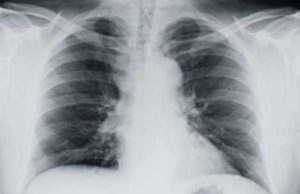
Mesothelioma is a particularly rare and deadly cancer that often originates in the mesothelium—the lining of tissue that protects several internal organs in the body. Mesothelioma cancer frequently develops from exposure to asbestos filaments or fibers. The bulk of mesothelioma patients will exhibit a detailed history with–whether through employment or private handling– asbestos fibers and/or filaments.
Mesothelioma cancer exists in several forms; however, the most common cases develop in the internal cavity of the chest and the outer lining of the lungs.
Common mesothelioma symptoms include: shortness of breath (derives from a build-up of fluid between the chest wall and lungs), incessant cough and unexpected or severe weight loss.
One of the reasons why mesothelioma sufferers have such a poor prognosis is because the disease is nearly impossible to detect during its infancy stages. Mesothelioma symptoms may lay dormant for years; the slow-developing symptoms may not become evident until 15-20 years following initial infection. Because of this, the majority of patients will not be aware of their medical infection until the cancer reaches stage III or IV. When mesothelioma cancer advances to this point, the disease is deemed inoperable—only palliative measures are possible.
Similar to other forms of cancers, mesothelioma is categorized by stage. When the disease progresses the outlook—regarding survival rate–becomes utterly dreadful. The insidious nature of mesothelioma cancer works in tandem with its inconspicuousness symptoms to create a fatal disease. An overwhelming percentage of mesothelioma patients will die from the cancer within a year of diagnosis. Because most mesothelioma patients are made unaware of their condition until the cancer has already metastasized, treatment options are largely palliative in nature.
Due to these bleak characteristics it is paramount that you take the proper precautions when handling asbestos and other agents that may promote the formation of mesothelioma tumors.
Mesothelioma Risk Factors:
The primary risk factors caused by mesothelioma cancer is asbestos exposure. Asbestos is a naturally-occurring mineral that was in wide-spread industrial use for its heat-resistant properties. Asbestos fibers are resistant to heat, making them effective in a wide variety of applications, including insulation, shingles, brakes, flooring and an assortment of other products.
When asbestos is broken up—common the mining process—dust is created. When this dust is swallowed or inhaled, the fibers settle in the stomach or lungs, where they can cause irritation that ultimately leads to mesothelioma. How this transformation takes place is not understood; it commonly takes 20 to 40 years for mesothelioma cancer to develop from asbestos exposure.
Moreover, some people, with decades of experience handling asbestos, never develop mesothelioma cancer. And yet, others, with only limited contact with asbestos exposure, will develop the cancer. This peculiar dichotomy indicates the presence of other factors in determining whether someone gets mesothelioma or doesn’t. For example, you may inherit a predisposition to mesothelioma cancer or a similar condition to increase your susceptibility.
Other Mesothelioma Risk Factors:
These factors may increase your risk of procuring the disease:
• Personal History in Dealing with Asbestos Fibers: If you have been in perpetual or direct contact with asbestos in the past, your risk of mesothelioma is greatly increased.
• Living With Someone Who Works With Asbestos Fibers: Individuals who are perpetually exposed to asbestos may carry the filaments or fibers home on their skin and clothing. These fibers may ultimately put others in the home at risk of mesothelioma cancer. Individuals who work with asbestos fibers must shower and change their clothes before they enter the household.
• Radiation: Research links mesothelioma cancer to the radioactive substance thorium dioxide. This substance was used in tandem with x-rays to diagnose various health conditions in the early 1920’s to the late 1950’s. Mesothelioma cancer is also linked to several radiation therapy treatments, particularly efforts to treat lymphoma and breast cancer.
• Genetic History: Family history of mesothelioma cancer will greatly increase your risk for developing the disease. That being said, more research is required to understand this relationship.






























